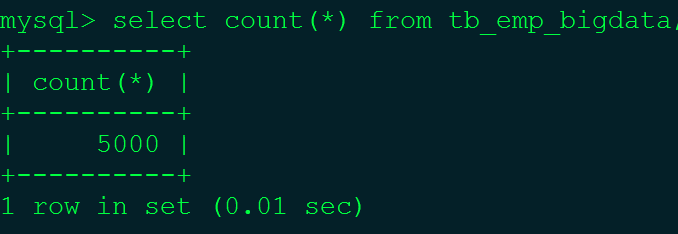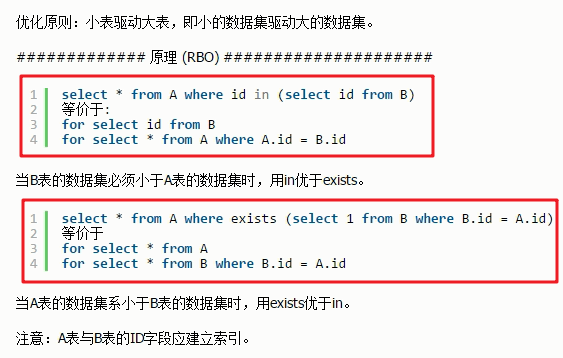小表驱动大表
一、为什么要小表驱动大表
类似循环嵌套。
for(int i=5;.......) { for(int j=1000;......) {} }
如果小的循环在外层,对于数据库连接来说就只连接5次,进行5000次操作,如果1000在外,则需要进行1000次数据库连接,从而浪费资源,增加消耗。这就是为什么要小表驱动大表。
二、数据准备
在tb_dept_bigdata表中插入100条数据,在tb_emp_bigdata表中插入5000条数据。


注:100个部门,5000个员工。tb_dept_bigdata(小表),tb_emp_bigdata(大表)。
三、案例演示
① 当B表的数据集小于A表数据集时,用in优于exists。
select *from tb_emp_bigdata A where A.deptno in (select B.deptno from tb_dept_bigdata B)
B表为tb_dept_bigdata:100条数据,A表tb_emp_bigdata:5000条数据。
用in的查询时间为:
![]()
将上面sql转换成exists:
select *from tb_emp_bigdata A where exists(select 1 from tb_dept_bigdata B where B.deptno=A.deptno);
用exists的查询时间:
![]()
经对比可看到,在B表数据集小于A表的时候,用in要优于exists,当前的数据集并不大,所以查询时间相差并不多。
② 当A表的数据集小于B表的数据集时,用exists优于in。
select *from tb_dept_bigdata A where A.deptno in(select B.deptno from tb_emp_bigdata B);
用in的查询时间为:
![]()
将上面sql转换成exists:
select *from tb_dept_bigdata A where exists(select 1 from tb_emp_bigdata B where B.deptno=A.deptno);
用exists的查询时间:
![]()
由于数据量并不是很大,因此对比并不是难么的强烈。
附上视频的结论截图:

四、总结
下面结论都是针对in或exists的。
in后面跟的是小表,exists后面跟的是大表。
简记:in小,exists大。
对于exists
select .....from table where exists(subquery);
可以理解为:将主查询的数据放入子查询中做条件验证,根据验证结果(true或false)来决定主查询的数据是否得以保留。
时刻与技术进步,每天一点滴,日久一大步!!!
本博客只为记录,用于学习,如有冒犯,请私信于我。


 浙公网安备 33010602011771号
浙公网安备 33010602011771号